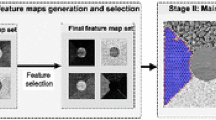Abstract
This paper presents an interactive method for 3D images segmentation. This method is based on a region adjacency graph representation that improves and simplifies the segmentation process. This graph representation allows the user to easily define some splitting and merging operations which gives the possibility to make an incremental construction of the final segmentation. To validate the interest of the proposed method, our interactive proposition has been integrated into a volumetric texture segmentation process. The obtained results are very satisfactory even in the case of complex volumetric textures. This same system, including the textural features and our interactive proposition, has been manipulated by specialists in sonography to segment 3D ultrasound images of the skin. Some examples of segmentation are presented to illustrate the interactivity of our approach.
Access this chapter
Tax calculation will be finalised at checkout
Purchases are for personal use only
Preview
Unable to display preview. Download preview PDF.
Similar content being viewed by others
References
Campadelli, P., Casiraghi, E., Exposito, A.: Liver segmentation from computed tomography scans: A survey and a new algorithm. Artificial Intelligence in Medicine 45, 185–196 (2009)
Oliver, A., Freixenet, J., Martí, J., Pérez, E., Pont, J., Denton, E.R., Zwiggelaar, R.: A review of automatic mass detection and segmentation in mammographic images. Medical Image Analysis 14, 87–110 (2010)
Olabarriaga, S., Smeulders, A.: Interaction in the segmentation of medical images: A survey. Medical Image Analysis 5, 127–142 (2001)
McGuinness, K., O’Connor, N.E.: A comparative evaluation of interactive segmentation algorithms. Pattern Recognition 43, 434–444 (2010)
Boykov, Y., Jolly, M.-P.: Interactive organ segmentation using graph cuts. In: Delp, S.L., DiGoia, A.M., Jaramaz, B. (eds.) MICCAI 2000. LNCS, vol. 1935, pp. 276–286. Springer, Heidelberg (2000)
Bartz, D., Mayer, D., Fischer, J., Ley, S., del Rio, A., Thust, S., Heussel, C., Kauczor, H.U., Strasser, W.: Hybrid segmentation and exploration of the human lungs. In: VIS 2003: IEEE International Conference in Visualization, pp. 177–184 (2003)
Gu, L., Peters, T.: Robust 3d organ segmentation using a fast hybrid algorithm. Compter Assisted Radiology and Suregery 1268, 69–74 (2004)
Tzeng, F.Y., Lum, E., Ma, K.L.: An intelligent system approach to higher-dimensional classification of volume data. IEEE Transactions on Visualization and Computer Graphics 11, 273–284 (2005)
Ben-Zadok, N., Riklin-Raviv, T., Kiryati, N.: Interactive level set segmentation for image-guided therapy. In: ISBI 2009: IEEE International Symposium on Biomedical Imaging, pp. 1079–1082 (2009)
Prabni, J.S., Ropinski, T., Hinrichs, K.: Uncertainty-aware guided volume segmentation. IEEE Transactions on Visualization and Computer Graphics 16, 1358–1365 (2010)
Baldacci, F., Braquelaire, A.J.P., Domenger, J.P.: Oriented boundary graph: A framework to design and implement 3d segmentation algorithms. In: ICPR 2010: 20th International Conference on Pattern Recognition, pp. 1116–1119 (2010)
Paulhac, L., Makris, P., Gregoire, J.M., Ramel, J.Y.: Human understandable features for segmentation of solid texture. In: Bebis, G., Boyle, R., Parvin, B., Koracin, D., Kuno, Y., Wang, J., Wang, J.-X., Wang, J., Pajarola, R., Lindstrom, P., Hinkenjann, A., Encarnação, M.L., Silva, C.T., Coming, D. (eds.) ISVC 2009. LNCS, vol. 5875, pp. 379–390. Springer, Heidelberg (2009)
Coleman, G., Andrews, H.: Image segmentation by clustering. Proceedings of the IEEE, 773–785 (1979)
Cardoso, J.S., Corte-Real, L.: Toward a generic evaluation of image segmentation. IEEE Transactions on Image Processing 14(11), 1773–1782 (2005)
Gusfield, D.: Partition-distance: A problem and class of perfect graphs arising in clustering. Information Processing Letters 82(9), 159–164 (2002)
Author information
Authors and Affiliations
Editor information
Editors and Affiliations
Rights and permissions
Copyright information
© 2011 Springer-Verlag Berlin Heidelberg
About this paper
Cite this paper
Paulhac, L., Ramel, JY., Renard, T. (2011). Interactive Segmentation of 3D Images Using a Region Adjacency Graph Representation. In: Kamel, M., Campilho, A. (eds) Image Analysis and Recognition. ICIAR 2011. Lecture Notes in Computer Science, vol 6753. Springer, Berlin, Heidelberg. https://doi.org/10.1007/978-3-642-21593-3_36
Download citation
DOI: https://doi.org/10.1007/978-3-642-21593-3_36
Publisher Name: Springer, Berlin, Heidelberg
Print ISBN: 978-3-642-21592-6
Online ISBN: 978-3-642-21593-3
eBook Packages: Computer ScienceComputer Science (R0)




